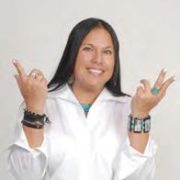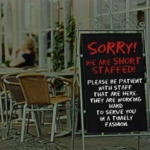chickee talk by Tina Marie Osceola
Surveying the Kissimmee Billie Slough
“The Seminole Science of Everglades Restoration”

In previous articles, I promised to share more about what I do at my “real job” as the Director of the Seminole Tribe of Florida’s Tribal Historic Preservation Office (THPO). Most folks have never heard of
historic preservation offices, let alone what kind of work they perform. Anyone wanting to know more, can read this incredibly long law, the National Historic Preservation Act (NHPA, 1966). The act created a relationship between states, tribes, local governments and the federal government and their preservation requirements. For the Seminole Tribe of Florida’s THPO, we have a staff of 25 people, mostly archaeologists
who perform the work required by federal law.
This month, I am focusing on one of the THPO’s largest sections, the Tribal Archaeology Section, led by Tribal Archaeologist, Maureen Mahoney. Maureen, a graduate of Florida State University, has been with the Tribe for more than a dozen years now and is not only a subject matter expert in Florida archaeology, but has defined Seminole archaeology or what I like to call “Seminole Science.” A primary focus of the Tribal Archaeology Section is to perform cultural resource surveys on tribal lands to avoid any adverse effects.
If you watch the History Channel, archaeologists are depicted more like treasure hunters looking for artifacts by using large earth movers or any means possible… I’m thinking about the Curse of Oak Island. However, the Tribe’s team of archaeologists use the least intrusive, disturbing methods possible when surveying tribal lands. This doesn’t sound as interesting as it really is, so this month I want to share photos from the field from one of our largest and most difficult projects ever embarked upon.
When the Everglades were drained by the Army Corps of Engineers, many critical areas to the ecosystem were negatively affected. The Kissimmee Billie Slough, located on the westernmost side of the Big Cypress Seminole Reservation, is one of those areas. As those responsible for Everglades Restoration politicize the
prioritization of those projects, the Seminole Tribe of Florida has stood firm in its desire to rehydrate the Kissimmee Billie Slough (KBS). The KBS is very important to the Seminole and its health is paramount to cultural survival.
Federal law being what it is under the National Historic Preservation Act, approximately 1,500 acres of the slough will be surveyed for cultural resources. The methodology requires that close to 7,000 holes will be dug by a team of five to six people. The team will identify and map out the cultural resources needing
protection when designing the Western Everglades Restoration Project. These resources include everything from archaeological sites, traditional plants and landscapes, historic camps, to burial resources. Community involvement is also critical to the project and members of Seminole Tribe will be interviewed, consulted, and involved. The Tribal Archaeology Section began this survey in December of 2022, and we predict that it could take anywhere from three to five years to complete.
When preparing to write this article, I asked those working in the field to send me photos they have taken and what their experiences have been while working in the field:
Shawn Keyte, the Crew Chief, and project lead, was responsible for drafting the methodology. He sent a photo that really makes what they face in the field every single day. There are no clear paths. There are dense areas of brush, trees, vines, water and sometimes wildlife. Shawn’s comments about his photo show that archaeology is more than just a job, it’s a vocation. A person must have a different level of consciousness. A person must be able to feel or hear what the natural environment is saying, “this photo has some meaning to me because I had stopped there for a break and I received a text [that a tribal member colleague’s father had died]. Over the past few months I’ve gotten to know [them] and have really learned about [their] connection to the earth and the land. I don’t know why, but after she texted, something clicked and I just felt like I understood the importance of where I was working and who I was working for. That’s when I took the photo. I sent it to her and said that I had found this beautiful spot in the slough and that I was going to take a break and think about her and her dad…I guess what I am trying to say is that working in the slough, in combination with getting to know more Tribal members on a personal level, has allowed me to really understand how important the native areas and slough are to the Seminole people.”
Josh Roche, an archaeologist who joined us early last year, sent an incredible photo of a “bear tree,” showing where a bear has been using it as a way to scratch its body. Josh also commented, “Sometimes working in the KBS is magical, you see some beautiful landscape that seems to have been untouched for ages, only for there to be an empty Gatorade bottle sitting three feet in front of you. The beautiful landscape quickly turns into an angry sea of sawgrass palmettos that yearn for blood. However the environment changes considerably, from palmettos to a pineland to a hammock, then to a swamp in the blink of an eye. Speaking of eyes, you really have to keep them open, for vines and wildlife. I haven’t run into one yet, but on the fringes of your senses you can hear something rustling separate of the wind, and it makes you remember that you are not alone out there. Honestly, being new to this field of archaeology as a whole, this area has been brutal for me. I leave the field with several new cuts each time, or with a pound of Caesar Weed on my clothes and hair!”
Jason Oliver, another archaeologist who joined us early last year, sent a really cool photo of a survey marker, once again illustrating that although that area seems untouched, it has been traveled, “the first one is of a tree tag or survey marker I saw on a random cypress tree. I showed Jack the photo and he said it may be a survey marker from the original survey in 1926.”
Jack Chalfant, Seminole Tribal Member and Cultural Resource Supervisor, focused on the amazing cypress trees they found in the slough. The photos he sent really illustrate the amazing landscape of this very traditional and important resource to the Seminole people.




Leave a Reply
Want to join the discussion?Feel free to contribute!